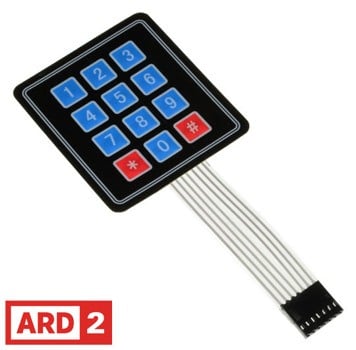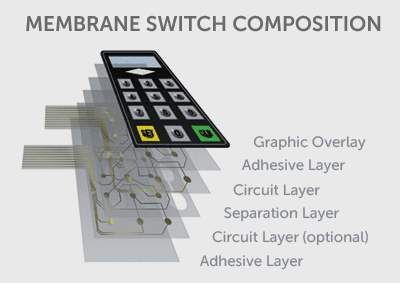Exploring the Different Types and Features of a Membrane Switch
Exploring the Different Types and Features of a Membrane Switch
Blog Article
Recognizing Membrane Switches: The Secret to Reputable and resilient Controls
Membrane changes stand for an important aspect of contemporary interface style, mixing functionality with resilience in numerous applications. These functional components not only promote individual interaction but are additionally engineered to stand up to the rigors of demanding atmospheres, from medical tools to commercial machinery. Understanding their building and construction, procedure, and the myriad benefits they offer is vital for engineers and designers alike. As we check out the details of membrane layer switches, it ends up being clear that their role in enhancing control systems is both extensive and complex, elevating concerns about just how best to take advantage of their capabilities in future developments.
What Are Membrane Layer Switches?
Membrane layer switches are a sophisticated service in the realm of user interface innovation, incorporating capability and design effortlessly. These gadgets serve as an interface between users and digital systems, incorporating a number of elements into a portable format. Typically constructed from flexible, thin layers of products, membrane buttons are developed to respond to touch, allowing customers to interact with machinery and digital gadgets properly.
The key components of a membrane layer switch include a published circuit layer, graphic overlay, and a spacer layer that avoids unexpected activation. The visuals overlay can be customized to mirror brand identification or user choices, improving appearances while making certain use. Membrane buttons are typically made use of in numerous applications, including medical gadgets, customer electronics, and commercial devices, owing to their sturdiness and resistance to environmental variables such as moisture and dust.
Among the essential advantages of membrane switches is their capability to stand up to damage, making them excellent for high-traffic atmospheres. Furthermore, they are light-weight and call for marginal room, enabling for innovative designs in product advancement. Overall, membrane switches stand for a efficient and functional option for modern electronic user interfaces, marrying technology with user-centric design principles.

Just How Membrane Switches Over Work
The operation of membrane switches over joints on a straightforward yet efficient system that converts individual input into electronic signals. When a user presses the button, the top layer deforms, enabling a conductive aspect in the circuit layer to make contact with a matching conductive pad on the underside of the graphic overlay.
The layout of membrane layer buttons can differ, yet they usually integrate domes or tactile aspects to give feedback to the customer, boosting the overall experience. The products used in membrane layer switches, such as polyester or polycarbonate, add to their longevity and resistance to ecological factors, consisting of moisture and dirt. The printed circuits are usually enveloped, which shields them from wear and tear over time.

Advantages of Membrane Buttons
One of the key advantages of membrane layer switches is their versatility in style, enabling them to be tailored to satisfy particular customer demands and visual demands. This adaptability reaches different industries, where various forms, dimensions, and colors can be utilized to boost user interaction and visual allure.
In addition, membrane layer buttons are understood for their sturdiness. Created from durable products, they are resistant to dirt, wetness, and physical wear, which substantially expands their life-span compared to typical mechanical switches. This toughness makes them specifically ideal for high-traffic settings and applications requiring longevity.

In addition, membrane switches supply a streamlined account, view publisher site leading to a thinner style that can be incorporated into numerous gadgets without adding mass. This function not only boosts the aesthetic appeal but additionally contributes to a much more ergonomic product design.

Applications of Membrane Buttons
Easy to use and functional, membrane layer switches locate applications throughout a wide range of sectors, including medical devices, consumer electronic devices, and industrial devices. In the clinical field, these switches are essential to tools such as diagnostic devices, client monitoring systems, and infusion pumps, where dependability and simplicity of cleaning are vital. Their capability to hold up against harsh environments and keep performance makes them optimal for such applications.
In customer electronic devices, membrane switches are used in products like microwaves, cleaning equipments, and push-button controls - membrane switch. Their streamlined design permits intuitive individual interfaces, enhancing the overall user experience while giving durability and resistance to tear and put on
Commercial tools also takes advantage of membrane layer switches, specifically in control panels for equipment and automation systems. These buttons use protection versus dirt and wetness, ensuring constant performance in challenging settings. Additionally, their customizable functions enable manufacturers to customize them to certain operational requirements, boosting effectiveness and capability.
Choosing the Right Membrane Layer Change
When choosing a membrane layer switch, it is necessary to consider different factors that influence performance and viability for particular applications. The main considerations consist of environmental conditions, responsive feedback, resilience, and style requirements.
First, analyze the operating environment; switches exposed to wetness, chemicals, or severe temperatures need particular products to make certain long life and capability. Next, review the need for responsive responses. Depending on user interaction, some applications may take advantage of a tactile reaction to validate activation, while others may choose a non-tactile style for visual reasons.
Longevity is one more essential factor; membrane switches should be developed to hold up against regular usage, impacts, and abrasion. Make certain the selected button can endure the anticipated lifecycle, especially in high-usage scenarios.
Verdict
In final thought, membrane layer switches over serve as important Get the facts components in the style of resilient and reliable control systems throughout different industries. The versatility of membrane switches over allows for customized services that satisfy details operational demands, strengthening their relevance in contemporary technology.
Membrane layer switches over stand for an essential aspect of contemporary user interface design, mixing capability with resilience in different applications.Membrane layer switches are an advanced remedy in the realm of individual interface modern technology, incorporating functionality and style seamlessly. Typically created from flexible, slim layers of materials, membrane layer switches are developed to react to touch, enabling individuals to connect with machinery and digital devices effectively.
The style of membrane layer buttons can vary, but they commonly include domes or responsive aspects to provide discover this comments to the individual, boosting the general experience.In conclusion, membrane changes serve as essential parts in the design of dependable and resilient control systems across various sectors.
Report this page